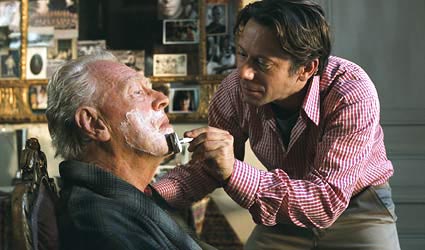How much is Julian Schnabel paying the film critics? There’s no other reason why intelligent film-goers would succumb to the sophomoric exercise in cinematic vanity that is The Diving Bell & the  Butterfly. Intrigued by raves from a wide range of reviewers, including local filmies, I wasted $7 and two hours on this pathetic excuse for a movie about a magazine editor confined to almost complete paralysis and the “life lessons” he learns thanks to attractive therapists, hand-held camerawork and of course, those crucial sub-titles.
Butterfly. Intrigued by raves from a wide range of reviewers, including local filmies, I wasted $7 and two hours on this pathetic excuse for a movie about a magazine editor confined to almost complete paralysis and the “life lessons” he learns thanks to attractive therapists, hand-held camerawork and of course, those crucial sub-titles.
Did Schnabel really think that making the film in French would elevate its mawkish, soporific effect? It doesn’t. It just means that you listen to lots of French speakers while you’re being bored to tears.
Wait, I know. Schnabel (a well-connected New York artist famous for painting on really big plates) decided to invoke the “Atonement effect.” You know, that’s where you shamelessly capitalize on a five-minute cameo by a major-but-aging star. In Atonement that chore went to the remarkable Vanessa Redgrave – and even her wonderfully eloquent facial expressions couldn’t pump gravitas into that over-rated exercise in art direction.
Schnabel’s home movie version of a true story — starring Mathieu Amalric (who looks a lot like Schnabel did about 25 years ago) – exploits the gifts of the once-mighty Max von Sydow to try to bring some dignity to The Diving Bell. It still tanks badly. We can only wonder just how desperately the veteran Swedish actor needed the cash in order to be part of a film that goes absolutely nowhere. That illuminates absolutely nothing. And worse.
Worse is that the movie rips off, borrows from and pales in comparison to the 2005 Academy Award-winning The Sea Inside, starring the magnificent Javier Barden. The great Spanish film also tells a true story of a hopelessly paralyzed man who exerts a charismatic effect on those around him. Schnabel must think that filmgoers are idiots who never leave the house – how could he think he could literally lift scenes and motifs from The Sea Inside and that somehow it would appear original? How could he think he could get away with ripping off a far better artistic effort — and that no one would notice?
The Diving Bell‘s vertiginous camerawork – largely shot by twisting the camera around and shooting through gauze – does induce a bit of seasickness. But nothing else.
Most first-year film students would have been embarrassed to have created such a mess — and ANY first-year film student could have done better. I was shocked at how bad a highly-hyped film could be. The Diving Bell has no clothes.

